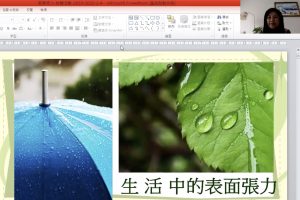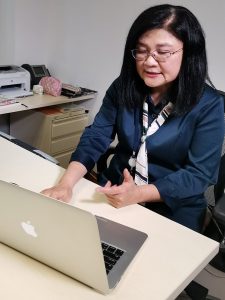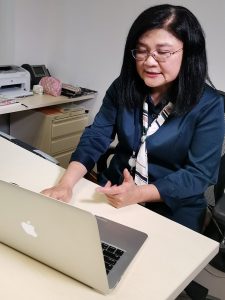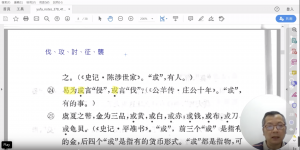Editor’s Notes: Since the novel coronavirus outbreak and the consequent suspension of classes to prevent the spread of the virus, online education has become a hot topic in Macao, Hong Kong, and mainland China. Here at the University of Macau (UM), faculty members have been offering online courses to ensure that students keep learning amid class suspension. In the upcoming My UM articles, we will cover the online courses from different faculties and departments and take a closer look at how faculty members prepare these courses and how they monitor the students’ learning progress.
Since the start of Chinese New Year, professors Zhou Yisu, Liu Naihua and Cheng Chun Wai in the Faculty of Education (FED) have been conducting online teaching. Their courses include ‘Comparative Education’, ‘Child and Family Education’ and is ‘Teaching and Learning of the Grammar and Rhetoric of Literary Chinese’.
Asynchronous Education
Prof Zhou has two computers on his office desk. He uses these computers to conduct online teaching and communicate with his students, and he records the teaching materials with his mobile phone.
Prof Zhou began experimenting with distance education two years ago. He would share all teaching materials, reading materials, videos, and his comments on student assignments on UMMoodle.
The ‘Comparative Education’ course he offers in this academic year is mainly taught with an asynchronous approach. ‘This gives students the flexibility to study at their own pace,’ he says. ‘I also give them mandatory and selective reading lists so they can choose the content that suits their level of ability and interest.’
Creating Electronic Course Materials
Prof Zhou also creates electronic course materials to facilitate learning. ‘Students can view my slides without having to download any software,’ he says. ‘I also upload reading materials and after-class questions on UMMoodle. Before each lecture, I create an audio file to explain all the slides used in that lecture. I edit the audio file and then upload it to UMMoodle. Then I discuss course content with my students on Zoon or Tencent Meeting.’
Prof Zhou has also created a WeChat group to answer students’ questions. For big-class undergraduate courses, Prof Zhou’s teaching assistant acts as the moderator between him and the students to communicate on their behalf. For small-class postgraduate courses, he communicates with the students directly. He also emails frequently with his students to monitor their learning progress, and plans to create more avenues for students to have real-time interaction with him.
According to Prof Zhou, it takes more time to prepare course materials with distance education. For instance, a three-hour-per-week teaching load usually requires him to prepare 50 to 70 pages of course materials, which takes around eight to ten hours. Take his ‘Comparative Education’course for example. In preparing the course materials for one unit about Cuba’s achievements in education, he designed 50 pages of course materials. He explains: ’Online education increases the amount of time required for preparing course materials because it’s different from education that takes place in a physical classroom.’
Technical challenge is another issue Prof Zhou has to overcome with online teaching. He explains, ‘Technology is not the end, it’s a means to an end, which is education. So my strategy is to focus on the content. No one teacher can incorporate all the latest technologies in his or her education. For that to happen, you need a professional team. The good news is that UMMoodle is really helpful, and the colleagues in the Centre for Teaching and Learning Enhancement provide great support in the process.’
Adjusting Content with Each Course
Prof Liu Naihua teaches four courses in this semester. They are Child and Family Education, Playing and Learning, Integrated General studies and Scientific Activities, and Guidance and Counselling in Early Childhood.
In addition to course materials, videos, and other reference materials, Prof Liu also uploads old student assignments to UMMoodle and Zoom. She also uses other platforms that are popular among the students, such as YouTube. For example, sometimes she would first upload a video to YouTube, and then provide suggestions in text or audio form while simultaneously soliciting student feedback in a WeChat group.
To address the lack of teacher-student interaction in distance education, Prof Liu makes a point of designing questions that inspire thinking and discussion. Students are required to select any one of the questions and write a report of about 1,000 to 2,000 words on the subject, which will be evaluated as part of the their overall performance in each course. She adjusts the content with each course. She says: ‘Distance education relies heavily on words and files, which increases the amount of time spent collecting and consolidating materials. Then you also need to record audio files, learn how to use new software, and edit the final products, which are even more time-consuming. So it’s necessary to adjust the content to suit this mode of education. The amount of time required in preparing before each class increases, but the upside is that it allows us to carefully review the course content in a way we wouldn’t have otherwise been able to, and it also removes the time pressure.’
With a Thin Veil in Between
Prof Liu thinks that one drawback of distance education is its lack of real-time feedback, discussion, and interaction that are often an integral part of classroom education. She also finds this the greatest challenge with online teaching. ‘With online education, it’s like there is a thin veil in between. There are many issues and difficulties that I hope I can gradually overcome and improve. It’s an ongoing trial-and-error process,’ she says.
New Course in Life Education
During the anti-epidemic period, Prof Liu not only closely monitors the students’ learning progress, but also offers a new course in life education, which is designed to help students maintain physical and mental wellbeing. She recorded a voice message to tell her students that she cared about their wellbeing. She also provides psychological counselling for those in need, teaches students how to practise reserve thinking, and offers other heart-warming suggestions to help students stay positive.
Upload Videos to Moodle
One of the courses Prof Cheng Chun Wai teaches in this semester is ‘Teaching and Learning of the Grammar and Rhetoric of Literary Chinese’. To help students feel as if they were studying the course in a classroom, Prof Cheng always records his computer screen with screen recording software while he explains the content and types or highlights the key points. He then uploads the video to Stream and posts the link to the video on UMMoodle so that students can click and watch the video.
Prof Cheng is no stranger to screen recording software, but when he first started preparing for the online course, he didn’t know much about how to produce or edit videos. ‘Producing course videos is not technically demanding, but it takes a bit learning,’ he says. Of course he has encountered some technical problems in the process, but he was always able to solve them quickly by consulting computer technicians at the university.
Prompt Testing to Assess Student Understanding
To add an element of interactivity in online education, Prof Cheng always designs one or two questions for each teaching video to test students’ understanding of the content. These questions usually come in the form of yes-or-no questions, multiple-choice questions, or short-answer questions. The system records the students’ names, email addresses, and answers to the questions so that Prof Cheng can check the answers. Students who have questions about the content can leave a message in the comments section. ‘It also takes some time for the students to adjust to this sudden change in the mode of education,’ he says. ‘It makes me so happy when my students tell me they like my videos, and they seem to be more active in answering the questions than when we first started this online mode.’
UMMoodleLaunched in 2008, UMMoodle is an online teaching platform at UM, where students can obtain course-related learning resources including text files, PPTs and video clips. They can also submit assignments and take quizzes on the platform.Website: https://ummoodle.um.edu.mo/
Learning resources from UM’s Centre for Teaching and Learning EnhancementWebsite: https://go.um.edu.mo/6rjvczah
Related articles:
Distance Education Series: Interviews with FAH Professors
Distance Education Series: Interviews with FLL Professors
Distance Education Series: Interviews with FHS Professors
Distance Education Series: Interviews with FSS Professors
Distance Education Series: Interviews with FBA Professors
Distance Education Series: Interviews with FST Professors
Source: My UM E-Version






